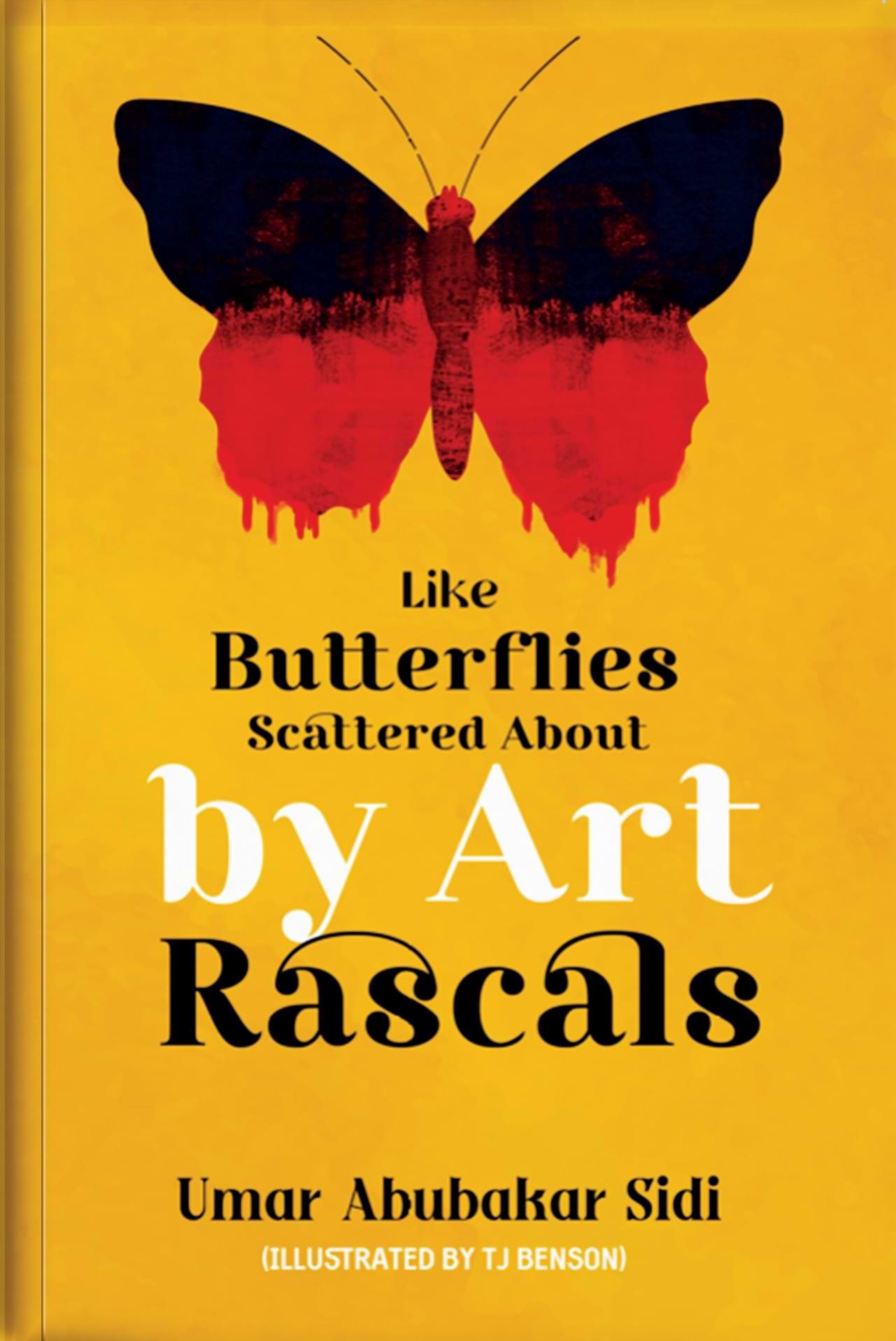
REFLECTIONS ON UMAR ABUBAKAR SIDI’S LIKE BUTTERFLIES SCATTERED ABOUT BY ART RASCALS
Umar Abubakar Sidi's poetry is one of the most talked about today in the Nigerian literary space, because of its unconventionality and departure from the new body of narratives dominated by water, body, and confessional motifs. Sidi’s poetry has assumed a controversial status among readers and critics alike also because of its iconoclastic leaning and obsession with Sufism and Surrealism ideologies. While Sufi and Surrealist poetics are not alien to Nigerian readers and especially to northern Nigerian readers because of the Islamic link to Sufism, they appeared to have been extinct until Sidi’s emergence on the scene with his debut collection, The Poet of Dust. It is therefore understandable why Sidi’s poetry has met critical and mediocre reception. The critical reception stems from readers who are aware of the intricate nuances of Sidi’s poetic experimentation and are unhindered by the buzz that it generates. While on the other hand, the mediocre reception ensues from a place of sheer sense of awe that Sidi’s poetry induces them. They are simply Sidi’s fans who love poetry and are unencumbered by the exigency of nuance and the functionality of the language of Sidi’s poetics.

The peculiarities associated with Sidi’s poetry are rooted not in the formation of an original poetic leitmotif but in the adoption and revival of a seemingly forgotten poetic tradition whose own emergence was rooted in deviancy against the formalities of reason and logic. Britannica, in reference to one of the surrealist’s most prolific advocates, Andre Breton, who published The Surrealist Manifesto in 1924, explains the crux of surrealist poetics thus, “Surrealism was a means of reuniting conscious and unconscious realms of experience so completely that the world of dream and fantasy would be joined to the everyday rational world in “an absolute reality, a surreality.” Salvador Dali provides a simpler definition of surrealism encapsulated by the following quote “Surrealism is destructive, but it destroys only what it considers to be shackles limiting our vision.” Based on the foregoing postulations, it suffices to surmise that the core of surrealism is dissidence, which invariably explains the enigmatic title of Sidi’s collection Like Butterflies Scattered About by Art Rascals.
Artists and poets alike have for centuries been regarded as renegades, non-conformists, or rascals whose forte is to wedge subtle wars against the existing status quo whether it is against the state, tradition, or establishment within the art space. Thus, it is safe to consider Sidi’s poetry within the larger discourse of contemporary Nigerian poetry as an embodiment of dissidence that belies the contemporarity of new Nigerian poetics. Like Butterflies Scattered About by Art Rascals manifest the unconventionality of the poet as a dissenter following the dictates of his heart rather than the dictates of conventionality.
Consequently, when we read Sidi’s poetry, we are not reading structured meaning, we are reading for insight into the variegated emotions, images, and dislocated metaphors assembled in what seems like a state of instability. In other words, one’s mind is prodded by pandemonic contemplation in contention of the meaning of the expressions in the collection. And because the foregrounding precepts of surrealism are dominated by dependence on the syndication of the unconscious and conscious realities thereby leaving a dilemmatic impression on the mind of the reader.

This dilemmatic impression perceived by the reader is deliberately orchestrated by Sidi to elicit the exact same effect in the reader. This feeling of ordinance or vagueness is accentuated by the use of a cardinal element of surrealism, Dadaism, which according to the Merriam-Webster Dictionary is “a movement in art and literature based on deliberate irrationality and negation of traditional artistic values.” The import of this style is that there is no sense of adherence to the raving order of rationality as the poet is free to express himself however he chooses to reflect the emotions running through his mind. This is what we encounter while reading Sidi. For example, the poem “The Forbidden Sahara Answering the Call of the Veiled Woman” (p.25-26) succinctly illustrates the assertion above as the persona in the third and fourth lines explains, “the gazer is struggling with disagreeable objects/between male and female identities”. In the poem, we are confronted with a crisis of unexplainable dualities which appear to have been recollected in a state of unconsciousness.
This perception of uncoordinated emotions is further accentuated by the following second to the last stanza of the same poem in which the persona alludes to the state of confusion running through the fabric of the poem when he posits that,
the gazer is walking towards the horizon away from us,
from the confusion of the central story of the veiled woman,
from the doubling instruction of a sign among
signs And in the last stanza of the poem, the persona seems to be reading our minds when he declares that “this is not a poem; it is a treachery of images”. The line is a symbolic representation of the fulcrum of this collection and the spine of this analysis. In summation, neither the poet nor his persona can determine what anyone makes of the collection of meaning or meaninglessness. The persona sees the appreciation of poetry as a personal endeavour undertaken by an individual in a quest for his or her own personal mystery. The persona helps us to understand this notion in the seventh stanza of the poem, “The First Manifesto or the Survey of the Eye” (p.27) in which he opines that,
Poetics is a choice made on instinctive personal ground,
it is the opposite of the expected, it is the spontaneous
gaze, a criterion on the notion of the marvellous
Sidi has never failed as a poet in providing direction or explanation on the essence of and what poetry means to him on a personal level. We have seen also this trend in The Poet of Dust as well, in what seems like a conscious attempt to indoctrinate his readers into his ideal of poetry. This is the impression the reader gets after reading “The First Manifesto or the Survey of the Eye” in which he conceptualises poetry in the light of the ideation of surrealism philosophy. In the poem, Sidi appropriates poetry as a dialogue between the conscious and unconscious realities. Sidi regards dialogue as a testament to the idea of surrealism when he posits that “The Surreal is afflicted with dialogue.” It is however in the following stanzas below that we truly engage with Sidi’s theorisation of surrealist poetry,
To open any survey of an art movement with the
possibility of arriving at a point of convergence requires
an association between dialogue and voice
If we consider the Surreal as dialogue with other Encounters by way of dreams, coincidences, the Uncanny reciprocal exchange connecting conscious and Unconscious
Our concern will then be what endures
Such as the poetry of the uncanny: Sidi’s obsession with surrealism is better regarded as a postmodern revisionist exercise which brings very little to the table in terms of the projection of a distinct artistic voice. While we might appreciate the particularity of style in terms of its being unpopular with younger who are fascinated clearly by this strangeness, we cannot afford to overlook the gap that this dalliance with exogenous motif creates in the literary firmament, especially in the face of the evolution of African poetry. While we are quick to renounce our affinity to African cultural ethos, we are more than eager to profess and propagate foreign ones that had their reign several decades ago. This is the sort of conviction that inspires African poets like Chijioke Amu-Nnadi to pride themselves as African replicas of Pablo Neruda.
The prevalence of the prosaic effect in the collection gives it away as a less meticulous work in comparison with The Poet of Dust which possesses a grander artistic forte. The download side of prosaic poetry is that it forces the reader to read prose in splintered sentences which leaves a sour taste on the tongue. More often than not dependency on the prosaic effect demarkets a poem as less ambitious and uninspiring. A good example is a poem entitled, “Poetics of Lame Logic” (51) which could simply have been conceived as an essay in full realisation of Sidi’s poetic manifesto.
So, why is Sidi’s poetry different from the other poetry written today? Sidi’s poetry leans towards the iconoclastic statement attributed to Christopher Okigbo where he stated that he “writes for poets.” Ironically, Okigbo is one of Sidi’s favourite poets and inspirations. Similarly, Sidi had declared at a recent public reading event at the Adam’s Pages Bookstore in Abuja, convened by the poet and literary administrator, Salamatu Sule, in his honour, that he does not think of the reader when he writes. He said that he does not concern himself with what the reader thinks of his work as he writes for himself. One might therefore ask, to whom does a poet write or why does a poet write? Is a poet his own reader?
If we were to agree with Sidi’s proclamation that he writes for himself and not for the reader, we would still be confronted with a problematic question that requires a deeper reflection. So, we cannot escape asking the question, who does the poet write for, especially when such a poet publishes his books, and makes them available in bookstores for public consumption? We could argue that a poet who writes for himself as Sidi affirmed would simply hide his manuscript from the public’s eyes. It is safe to say that the poet is driven by external and internal influences which I would briefly attempt to expatiate. Firstly, the external influence is driven by the poet’s desire to be regarded by the outside world or the public and this need is fulfilled and enabled by the feedback of the reader, thus silently the poet desires to be read which explains why the poet’s works are made public in the first place. The desire to be heard or read is as powerful as the internal influence that controls the poet. On the other hand, the internal influence is fuelled by the self-satisfaction that comes from the consciousness of knowing one’s own merit, the poet is contented with his own genius and takes delight in being understood only himself. Self-awareness manifests differently in different poets. For example, the late fiery bard, Ebereonwu’s manifested in how he titled his books, a case in point is the collection, Suddenly God was Naked. To many religionists, Ebereonwu’s title might be regarded as blasphemous and provocative because of its brazen reference to God’s nakedness. Similarly, conservatives would find the title of Moses Terhemba Tsenôngu’s collection, Before I Kill God and Other Poems sacrilegious and insensitive because of its boldness in insinuating that God could be killed. While the poems bearing these titles might not in themselves be demeaning of God, the sensitive reader is certain to find them repulsive. But the point to note is that these kinds of titles or statements come majorly from poets that have attained a certain level of self-consciousness of their creative geniuses. These brevities ensue largely from poets who have attained self-containment artistically, they write without recourse to the sentiment of readers because, like Sidi, they write not for the reader but for themselves and to fulfil personal idiosyncrasies. Whether in Okigbo, Sidi or the aforementioned poets, the sense of self-consciousness is evident. It is the nature of poets across generations to seek to stand out from the crowd and define their art as they considered suitable. But the question remains, for whom does the poet write? Perhaps, it is ironic that no matter the level of the idiosyncrasy of a poet, they are very much interested who keeps faith in their art, and we have seen this in the huge reception that Sidi’s poetry enjoys despite his declaration that he does not think of readership when he writes. Whether one admits it or not, the poet is amused by the reader’s ability or inability to comprehend or appreciate his or her works. The poet is provoked by the reader’s ability to appreciate his or her work no matter how insignificant that appreciation might be. The relevance of the reader is in two ways; an enlightened reader delights the poet while an unenlightened reader amuses the poet. Either way, the reader is at the core of the work of a poet.
How do we as readers for whom Sidi does not write approach the appreciation of his poetry without sounding like the unenlightened reader? Perhaps, we would need to ask Sidi to teach us how to read his poetry correctly such that we would become the readers he writes for. As a critic, I have taken the risk more than once to amuse Sidi and even myself with my attempts at appreciating his poetic eccentricities, and it is with that record of bravery that I am yet again indulging myself in amusing him further with another attempt at engaging his latest offering albeit from equally a nonconformist’s point of view. As a critic, it is permissible to say that I don’t indulge in criticism for the sake of the poet but to pay my allegiance to the art of criticism.
Sidi’s unique standing as a poet is not in a vacuum, his poetry exists within a body of works referred to as “contemporary” or ‘new Nigerian poetry’ depending on who the inquirer is. It is instructive therefore to deviate a little into the larger discourse of the context within which Sidi’s poetry exerts its own identity. Nigerian poetry continues to evolve with the passing of age hence understanding some of the recent evolutions in the genre regardless of their appropriateness is central to appreciating the poetic offerings of the new generation often recognised as the thematically deviant generation. The late cerebral scholar and writer, professor Pius Adesanmi alluded to this thematic deviancy at several fora such as the 2012 International Convention of the Association of Nigerian Authors, the 2014 edition of the Muazu Babangida Aliyu International Literary Colloquium and similar gatherings, where he repeatedly stressed the absence of national consciousness in the poetry of contemporary Nigerian poets.
For anyone that has been following the recent trends in contemporary Nigerian poetry in the last ten years, it would not be strange to observe that the focus of the new poets has drastically shifted away from what the poet, literary critic and scholar, Professor E.E Sule describes as “protest poetics” or the “poetics of national consciousness” which hitherto now defined Nigeria’s poetry. Protest poetics as Sule has explained at different events is an offshoot of the Nigerian socio-Marxist school of thought that conceived poetry and literature as a means of protest and engagement with the Nigerian State. This school of thought reasoned that poetry and literature owe society a duty to hold the ruling class accountable to the common man or woman. In other words, poetry provided an escape from the regime of military suppression and gave voices or agency to the ordinary people to engage the state. This was the dominant concern of the poetics of the ‘80s and ‘90s generation who were perturbed by the failing state of affairs in the country which led to a massive brain drain which many inquirers described as the genesis of Nigeria’s intelligentsia’s exodus to foreign lands in search of free spaces of expressions and greener pastures. It has been discussed by many scholars that this was the period that witnessed the mass exile of Nigeria’s best brains to western countries. This voluntary exile by some of Nigeria’s finest brains continues to this day.
The leadership failure occasioned by the ineptitude of the political class and regimes of terror fostered by years of military dictatorship had given rise to a wave of protests and poets were central to the quest by the citizens to reclaim what they perceived as the lost soul of the country. It was within this socio-political context that the preceding generations of Nigerian poets and writers formed their poetic consciousness and engagement with the state as critical stakeholders. Prior to Nigeria’s and many African countries independence, early African writers engaged the colonial systems across the continent with their poetry which was chiefly aimed at building consciousness among Africans towards the decolonialisation agenda. Early African writers used poetry and literature in general as a tool to engage the colonialism discourse thereby entrenching a culture of protest poetry as Professor Wole Soyinka describes it in his introduction to Poems from Black Africa*. Subsequently, succeeding generations of African poets continued with the tradition of problematising socio-political consciousness in their works, especially in their poetry.
However, fast-forward to the 2000s, the thematic preoccupation of the new crop of poets and writers began to change across the continent of Africa. The height of this thematic change rose in the 2020s with a significant shift from modernist concerns to what the renowned critic and scholar, Professor Charles Nnolim referred to as the “hedonistic or fleshly era” which witnessed the rise in particular in Nigerian literature with a focused on the celebration of urban life and the flesh. The 2010s witnessed a drastic change towards individualism and confessionalism. The emerging poets began to concentrate on dealing with their personal realities with an emphasis on attaining self-realisation within the social milieus in which they found themselves. Their poetry concentrated on their dissatisfaction and inability to find fulfilment in a society they perceived as threatening to their existence and attainment of a meaningful life. They began to refer to the country as a hostile and hopeless space in which their dreams could not be realised. However, by 2010, a new crop of poets began to emerge with new tropes and consciousness which tilted towards the ideals of confessionalism and individualism. As these new crops of poets gained prominence largely on social media and foreign journals aided by the advent of the Internet, confessionalism and individualism soon gained phenomenal traction among younger Nigerian poets and writers.
The American poet, Sylvia Plath became a prominent figure in the discourse of poetry by these new poets predominantly on social media. Plath became a reference point and muse to many of the new poets, of course, this was enabled by the internet and foreign journals which dictated the direction of the new poets largely because they rejected poems that didn’t fall into their prescriptive themes. And to be accepted by these journals, the young African poets had to doctor their works to fit into the prescriptions of the journals. As would be expected many of them became instant celebrities, whose poetic worth was measured by the number of international journals in which they were published. Gay rights movements also gained critical traction during this period as the internet and social media were the common room for these conversations.
Many of these poets became the faces of gay rights in Nigeria, and this became a basis for many of them gaining recognition internationally some of them eventually gained fellowships abroad as a result of their roles in the struggle for gay rights propelled by a sense of victimhood. This was also the period when the water and body motif became the major metaphors in the works of these poets. A poem seemed meaningless without the body, water and mother motif, and this was rooted in the philosophy of confessionalism. These set of poets developed consciousness towards their individuality and disenchantment with the state, they hammered on the failed leadership of the state which had no hope of a meaningful life for life. The state became an embodiment of repression and hopelessness for them hence they struggled mentally and emotionally to disconnect themselves from the social realities that were traumatising them. The cries of hopelessness saturated social media conversations and the yearning for exile became the order of the day. They began to yearn earnestly to leave their country for foreign lands which supposedly held better promise and prospects for them.
The American prose poetry tradition also became famous among the new poets at this time. As they gained more acceptance, they gradually disconnected themselves from any indigenous literary movements or traditions. They began to regard and call themselves international poets and denounced any affiliation to African cultural realities, they argued that their writings were for an international audience and couldn’t limit themselves to the local tag of being called African or Nigerian poets. There were several debates on social media about what constitutes being an international or an African poet during this period. International platforms dedicated to the promotion of African poetry like the African Poetry Book Fund and the Brunel International African Poetry Prize fuelled the relegation of any sense of cultural or poetic affinity to African poetic consciousness or tradition. They were majorly biased towards the canonisation of poetry that celebrated the new confessionalism, individualism, homosexuality and subjects that pander to the whims and caprices of Western ideals. This led to a disconnect that enabled a deeper sense of exile in the young poets who even though were still living in Nigeria and Africa felt alien to their motherland. They spoke of the motherland with the language of estrangement, and the resultant consequences included mental breakdowns and suicide by young poets who lost hope in the face of what they regarded as a state of hopelessness in the country.
This disconnect has become the defining point in contemporary Nigerian and indeed African poetry today. Exogenous ideation has taken the centre stage in contemporary Nigerian poetry. New Nigerian poetry is being shaped by the embrace of foreign precepts that continues to undermine the development of African poetry. This is the reality that makes Sidi’s poetry stand out as a unique intervention amidst the dominant trend. While the craving for foreign acceptance raged, Sidi released his first collection, The Poet of Dust which is a departure from the current trend and also a departure from the generation of protest poetics. He reintroduced the forgotten form of Sufi and Surrealist poetics which was instantly celebrated for its fresh perspective and thematic focus. It gained wide acceptance because people were yet again experiencing a different form of poetry that was strangely familiar.
The Poet of Dust was considered deep and mystical, and it went on to inspire a renewed wave of Sufi consciousness among younger poets mainly in northern Nigeria. Young Sufi poets who regarded themselves as the disciples of Sidi began to emerge on the literary scene. Popular among this crop of poets is the brilliant Ba Sabouke, who openly celebrates Sidi’s influences on his own poetry and who along with others has begun to refer to themselves as Sufi poets. It suffices to say that, Sidi provided alternative thinking with his debut collection which he has consolidated with the new surrealist-inspired collection Like Butterflies Scattered About by Art Rascals.
Paul Liam
Paul Liam is a poet, literary critic, and author of two poetry collections; Indefinite Cravings (2012) and Saint Sha’ade and Other Poems (2014). He has published several critical essays and reviews on contemporary Nigerian writers. A 2014 Fellow of Ebedi International Writers Residency, Oyo State, he is currently the Head of Operations of Isu Media Limited, a development communication company based in Abuja.




Comments